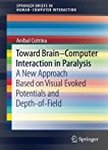版权所有:内蒙古大学图书馆 技术提供:维普资讯• 智图
内蒙古自治区呼和浩特市赛罕区大学西街235号 邮编: 010021

丛 书 名:Human–Computer Interaction Series
版本说明:1st ed. 2017
I S B N:(纸本) 9783319522975
出 版 社:Springer International Publishing
出 版 年:2017年
页 数:xvi, 96 pages :页
主 题 词:Brain-computer interfaces. Brain mapping. Human-computer interaction. Paralysis Paralytics Treatment Technological innovations. Rehabilitation.
学科分类:0710[理学-生物学] 07[理学] 071006[理学-神经生物学]
摘 要:This book presents up-to-date information on Brain-computer Interfaces (BCI). BCIs are systems that record brain signals, extract features and translate them into computer commands. For instance, in BCIs based on the steady-state visual evoked potentials (SSVEP-BCI), brain potentials evoked by visual stimuli are used for controlling computer-based devices. Inspired by the optical phenomenon of depth of field, this book introduces, describes, and evaluates a novel way of setting visual stimuli for SSVEP-BCI. It employs two stimuli that were placed at different distances from the subjects so that if one stimulus is focused on, the other one is non-focused. This assessment allows SSVEP-BCI users to modulate their brain signals by shifting their focus because focused and non-focused stimuli evoke different brain potentials. It allows people to send two brain commands with high accuracy rate by shifting their focus. Hence, computer interaction systems can be proposed for people with paralysis, such as patients with amyotrophic lateral sclerosis since focusing mechanism does not demand head, neck, or eyeball movements. The matter assessed in this book that includes offline and online experiments, is useful for researchers in human-machine interaction who are looking for relevant possibilities of improving the quality of life of people in paralysis situation.